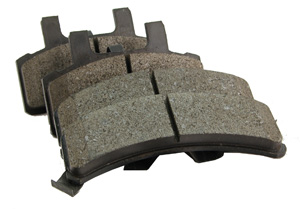A. Ceramic friction materials have been around for many years, and are often used for the disc brake pads on many late model vehicles. Ceramic pads are typically quieter than semi-metallic linings, resist wear better than most non-asbestos organic (NAO) linings, and produce little visible brake dust.
 But recently, some carmakers (such as GM) have shifted back to harder semi-metallic linings for some applications to extend pad life and to reduce stopping distances. Semi-metallic linings have superior high-temperature stopping power and better fade resistance, but may also increase rotor wear.
But recently, some carmakers (such as GM) have shifted back to harder semi-metallic linings for some applications to extend pad life and to reduce stopping distances. Semi-metallic linings have superior high-temperature stopping power and better fade resistance, but may also increase rotor wear.
Consequently, though the pads last longer, the rotors may also have to be replaced when it’s time for a pad change.
Some vehicle manufacturers also are mixing friction materials on the same wheel. A semi-metallic pad may be used on one side of the rotor and a ceramic or non-asbestos organic pad on the other. The reason for doing so is to take advantage of the different braking, noise and wear characteristics that each type of friction material offers.
Typically, NAO friction materials have a low metallic content (usually less than 30 percent), but that percentage can vary with the product and application. Semi-metallic friction materials have a high metallic content, typically 50 to 60 percent or more chopped steel wool fiber. Ceramic friction materials usually contain little or no metallic content, but include various types of ceramic fibers or particles can range from 0.4 to as much as 80 microns in diameter.
Q. Are there any standards for comparing friction materials?
A. Yes. One such rating method is the SAE J661 and J866A Brake Lining Quality Control Test, also called a “Chase” test. A one-inch square of friction material is placed in a special machine that measures the material’s coefficient of friction over a range of temperatures.
From this, the low- and high-temperature friction ratings for the material are determined and printed as a two-letter edge code on the brake linings.
The edge code letters for most passenger car and light truck linings are some combination of E and F, while G and H are found primarily on racing pads. The coefficient of friction range for E is 0.25 to 0.35 (least aggressive), F is 0.35 to 0.45, G is 0.45 to 0.55, and H is 0.55 to 0.65 (most aggressive).
Edge codes tell you something about how a particular set of brake pads feel and behave as they get hot, but it tells you nothing about how quickly they recover from fade, how they wear or how much noise or dust they make.
As a rule, the better the friction material, the more consistent will friction characteristics will be under different temperatures and pressures. A friction material rated FE will provide good braking when cold, but may fade when it gets hot. A material rated EF may take a little more pedal effort when cold, but will experience less fade as it gets hot. Friction materials rated FF and higher are often recommended for performance applications.
Brake dynamometer tests such as SAE J1652 also can be used to verify the friction characteristics of a given brake lining material. The dyno uses an actual brake assembly (drum or disc) to stop a large rotating flywheel. The mass of the flywheel simulates the momentum of a vehicle coming to rest.











